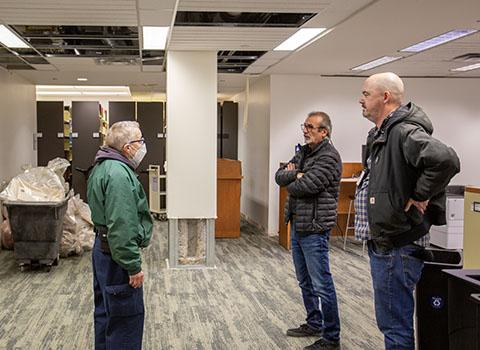Energy efficiency sets stage for transformation

Control technician Aric Chavez sets up a digital control system in Benson Hall, as part of the UW's energy efficiency efforts.
At home, there are simple steps you can take to save energy: program your thermostat, fix a leaky pipe, tell the kids to turn off the light when they leave the room, and so on. Smart home devices make doing this even easier, automatically increasing or decreasing energy usage to match your activity.
At the UW, the same principles apply. But instead of one house, there are 170 buildings with a range of functions, from labs to residence halls. Instead of 2,000 square feet, there are 19 million. Instead of one thermostat controlling a few pieces of equipment or zones, at the UW, each building may have 100 zones.
Building use plays a big role in overall global energy consumption, and the size of the University makes the challenge to reduce that consumption both more complicated and more urgent. Improving energy efficiency is a key to fighting climate change and meeting the UW’s sustainability goals.
“If you don’t need to use it, don’t waste it, right?” said Norm Menter, assistant director of energy and resource conservation with UW Facilities (UWF). “Use only as much energy as you need. It’s a basic sustainability principle that underlies everything else.”
Energy efficiency is ‘foundational’ first step
Energy efficiency is ‘foundational’ first step
Improving energy efficiency is the first stage in UW’s larger energy transformation strategy, which seeks to decarbonize the UW campus.
The UW’s energy consumption per square foot of building space is currently nearly twice as high as state targets. The UW campus has many older campus buildings that no longer operate as originally intended. Energy efficiency work is tied to modernizing the systems that operate the buildings.
Menter calls energy efficiency “foundational” to the energy transformation strategy, which involves creating a new energy infrastructure.
“We want to build the new sustainable energy generation and distribution systems to be compatible with what the campus actually uses in energy and not build the system to waste energy," he said. “By eliminating the waste, we build upon an optimized system, rather than a system that's inefficient.”
Focusing on campus-wide energy efficiency is not new. In 2015, UWF completed an energy audit of campus buildings, focusing on the biggest sources of waste and opportunities for improvement. At that time, UWF found over 400 energy saving opportunities, including leaky steam valves, broken equipment and entire HVAC systems that needed to be replaced. With years of work now completed or underway, the program for making these fixes, called the Resource Conservation Program, is self-sustaining, meaning the savings from reduced energy will match the costs of making the changes.
Making these kinds of improvements also gives the UW the opportunity to lay the groundwork for the future, just as you might see a flooded basement as an opportunity to create your dream family room.
For example, in 2013, UWF did an audit of Gowen Hall. Built in 1932, the building sits on the southeast corner of the Quad. The energy audit found that a steam coil for an air handling unit serving classrooms and offices had failed. UWF was able to use maintenance and resource conservation funds to replace and modernize not only the broken coil, but all the building’s coils.
Now, Gowen will be ready when the UW moves away from steam for heating campus, which is the source of 93% of its greenhouse gas emissions, to a more sustainable hot water system.
Let’s get digital
Let’s get digital
In big cities, apartment buildings may be managed by a superintendent, whose job is to do routine maintenance. They ensure repairs are made, things are in good working order, everybody has hot water and so on. You might do the same thing in your house, checking the thermostat and making fixes where needed.
At the UW, it’s not practical to have that level of support for every building. That’s where technology comes in handy. UWF is in the process of installing digital meters and digital controls, which allow staff to monitor and adjust energy usage for many buildings in an optimized way.
Digital meters show energy consumption continuously and in real time, providing a richer set of data than what’s available when someone has to go out to read a meter. The meters show how energy consumption changes over time, how consumption corresponds to temperature and other variables, and more.

To monitor water and air systems, technicians used to have to go to the mechanical room to check a panel, like the one pictured from More Hall. Now with digital controls, lead technician Dan Fringer can monitor them from a laptop.
UWF can use digital controls to manage, monitor and automate conditions from a remote location. They also offer data about conditions inside the buildings, such as temperature and humidity, to more precisely target heating and cooling demand.
For example, Schmitz Hall was recently upgraded from a pneumatic control system to a digital control system, which can adjust the temperature of the air used to heat the building based on the temperature outside.
“When it's warmer out, we don't need the discharge air to be as hot,” said UWF energy engineer Robert Gaynor. “We save on heating energy while still maintaining the temperature of the building.”
The data collected through digital meters and digital controls come together through data analytics, an aspect of UWF’s energy efficiency work that will be built out over the next five years. Through data analytics, UWF will be able to create alarms and visualizations to identify problems or deviations from energy efficiency standards over time, before they are felt by building occupants.
Seeing what’s really going on inside a building is critical to energy efficiency and planning for the future, Menter said.
“That's the big dream: Use data so that we can use energy in a very thoughtful and planned way to avoid overwhelming Seattle City Light and make our buildings as flexible and durable as they can be — and use energy when it's available, then coast or conserve when resources are really constrained,” he said. “That allows us to add solar and wind, even hydro, and use sustainable resources more efficiently and effectively.”
Investing for the future
Investing for the future
Saving energy is good for the UW’s pocketbook as well as for the environment. Under the state's new Climate Commitment Act, most of the state’s biggest emitters of greenhouse gases, including the UW, must purchase “emission allowances” at a quarterly “pay to pollute” auction. Revenue from the first auction in February totaled $300 million, and revenue from the second auction in May totaled over $500 million.
State law mandates the money raised in these auctions be invested in “critical climate projects.” That means some of it is coming back to the UW and helping to fund its energy efficiency efforts. From the February auction, for example, $15 million was allocated to the UW for energy modernization and energy infrastructure.
UWF plans to use the money to add energy meters, upgrade control systems, and collect and analyze all campus energy data with new data analytic tools.
Energy efficiency modernization helps the UW on multiple levels.
“It's a quantum leap in everything around it both in terms of energy usage and also reliability for the customer themselves,” said Dan Fringer, a lead technician on the digital controls team. “It's a really good thing for the University."
And it’s a good thing for staff, too.
“These conservation projects are really good for our group because we can grow with them,” said Rich Dierck, assistant director of Facilities Construction.
“It's a lot of small things adding up to a big thing, and it’s enjoyable for us,” said Fringer. “This work actually has an indirect way of helping people — locally and globally.”





